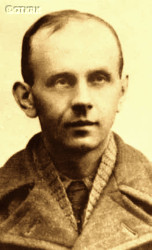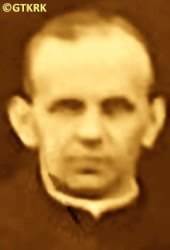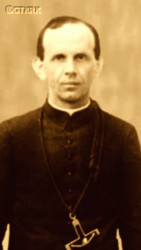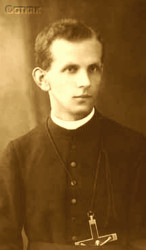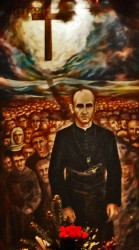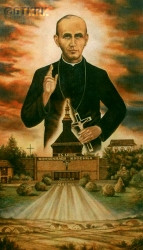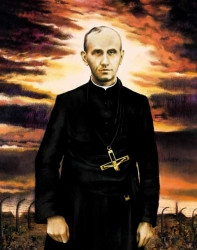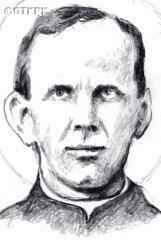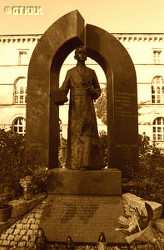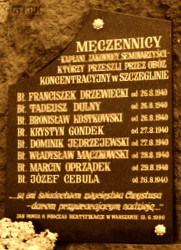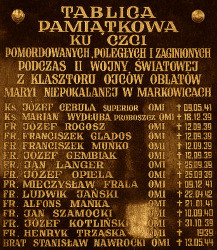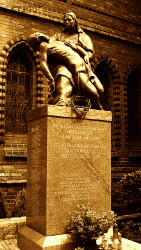Roman Catholic
St Sigismund parish
05-507 Słomczyn
85 Wiślana Str.
Konstancin deanery
Warsaw archdiocese, Poland
full list:
displayClick to display full list

searchClick to search full list by categories
wyświetlKliknij by wyświetlić pełną listę po polsku

szukajKliknij by przeszukać listę wg kategorii po polsku

Martyrology of the clergy — Poland
XX century (1914 – 1989)
personal data
religious status
blessed
surname
CEBULA
forename(s)
Joseph (pl. Józef)
beatification date
13.06.1999more on
www.swzygmunt.knc.pl
[access: 2013.05.19]

the RC Pope John Paul IImore on
en.wikipedia.org
[access: 2014.09.21]
function
religious cleric
creed
Latin (Roman Catholic) Church RCmore on
en.wikipedia.org
[access: 2014.09.21]
congregation
Congregation of Missionary Oblates of Mary Immaculate OMImore on
en.wikipedia.org
[access: 2013.05.19]
(i.e. Oblates)
diocese / province
Polish province OMI
Gniezno and Poznań archdiocese (aeque principaliter)more on
www.archpoznan.pl
[access: 2012.11.23]
Polish provincial vicariate (vice‐province) OMI
Katowice diocesemore on
en.wikipedia.org
[access: 2013.05.19]
date and place
of death
09.05.1941

KL Mauthausenconcentration camp
today: Mauthausen, Perg dist., Salzburg state, Austria
more on
en.wikipedia.org
[access: 2022.01.09]
details of death
After German invasion of Poland in 09.1939 and start of the World War II, after start of German occupation, arrested on 11.11.1939 by the Germans and jailed as a hostage in Strzelno prison.
Released on 17.11.1939.
Arrested again on 26.08.1940 and jailed in DL Scheglin transit camp in Szczeglin.
Released after few days.
Finally on 02.04.1941 arrested again.
Jailed in Inowrocław prison.
From there on 28.04.1941 transported to KL Mauthausen‐Gusen concentration camp where slaved in quarries and where perished: tortured and murdered by rifle bullets.
cause of death
murder
perpetrators
Germans
sites and events
KL MauthausenClick to display the description, KL Mauthausen‐GusenClick to display the description, InowrocławClick to display the description, DL ScheglinClick to display the description, «Intelligenzaktion»Click to display the description, Collective responsibility („Hostages”)Click to display the description, Ribbentrop‐MolotovClick to display the description, Pius XI's encyclicalsClick to display the description
date and place
of birth
23.03.1902

Malniatoday: Gogolin gm., Krapkowice pov., Opole voiv., Poland
more on
en.wikipedia.org
[access: 2021.04.02]
parents
CEBULA Adrian
🞲 06.09.1868, Malniatoday: Gogolin gm., Krapkowice pov., Opole voiv., Poland
more on
en.wikipedia.org
[access: 2021.04.02] — 🕆 13.05.1938, ?

BUHL Rosalie
🞲 29.06.1963, Stara Kuźniatoday: part of Prószków, Prószków gm., Opole pov., Opole voiv., Poland
more on
en.wikipedia.org
[access: 2022.01.12] — 🕆 09.04.1930, ?
baptism
24.03.1902

Otmęttoday: district of Krapkowice, Krapkowice gm., Krapkowice pov., Opole voiv., Poland
more on
en.wikipedia.org
[access: 2021.04.02]
Assumption of the Blessed Virgin Mary RC church
religious vows
15.08.1922 (temporary)
15.08.1925 (permanent)
presbyter (holy orders)
ordination
05.06.1927

Katowicetoday: Katowice city pov., Silesia voiv., Poland
more on
en.wikipedia.org
[access: 2021.08.12]
positions held
1937 – 1940
superior — Markowicetoday: Strzelno gm., Mogilno pov., Kuyavia‐Pomerania voiv., Poland
more on
en.wikipedia.org
[access: 2021.06.07] ⋄ Immaculate Conception of the Blessed Virgin Mary Congregation's house, Oblates OMI — also: master of novitiate
1936 – 1937
superior — Obratoday: Wolsztyn gm., Wolsztyn pov., Greater Poland voiv., Poland
more on
en.wikipedia.org
[access: 2021.12.18] ⋄ St Bernard Congregation's house, Oblates OMI
1936
Provincial — Polish Province, Oblates OMI — appointee, refused to accept
1931 – 1936
superior — Lubliniectoday: Lubliniec urban gm., Lubliniec pov., Silesia voiv., Poland
more on
en.wikipedia.org
[access: 2021.04.02] ⋄ St Stanislav Kostka the Confessor Congregation's house, Oblates OMI
1928 – 1931
friar and teacher — Lubliniectoday: Lubliniec urban gm., Lubliniec pov., Silesia voiv., Poland
more on
en.wikipedia.org
[access: 2021.04.02] ⋄ Minor Theological Seminary i.e. Juniorate (equiv. to gymnasium), St Stanislav Kostka the Confessor Congregation's house, Oblates OMI — lecturer of Polish, French, mathematics and geography, tutor; also: confessor
till c. 1927
student — Chumiętkitoday: Krobia gm., Gostyń pov., Greater Poland voiv., Poland
more on
en.wikipedia.org
[access: 2022.11.20] ⋄ Higher Theological Seminary i.e. Scholasticate, St John Cantius the Confessor Congregation's house („Krobia”), Oblates OMI — prob.
from c. 1923
friar and teacher — Lubliniectoday: Lubliniec urban gm., Lubliniec pov., Silesia voiv., Poland
more on
en.wikipedia.org
[access: 2021.04.02] ⋄ Minor Theological Seminary i.e. Juniorate (equiv. to gymnasium), St Stanislav Kostka the Confessor Congregation's house, Oblates OMI — lecturer of Polish language; also: private studies at the level of the Higher Theological Seminary, i.e. Scholasticate
c. 1922 – c. 1923
student — Liègetoday: Liège prov., Wallonia reg., Belgium
more on
en.wikipedia.org
[access: 2022.07.16] ⋄ Higher Theological Seminary i.e. Scholasticate, Oblates OMI
14.08.1921 – 15.08.1922
novitiate — Markowicetoday: Strzelno gm., Mogilno pov., Kuyavia‐Pomerania voiv., Poland
more on
en.wikipedia.org
[access: 2021.06.07] ⋄ Immaculate Conception of the Blessed Virgin Mary Congregation's house, Oblates OMI
1921
accession — Oblates OMI
1920 – 1921
pupil — Krotoszyntoday: Krotoszyn gm., Krotoszyn pov., Greater Poland voiv., Poland
more on
en.wikipedia.org
[access: 2021.07.18] ⋄ Minor Theological Seminary i.e. Juniorate (equiv. to gymnasium), Congregation's house, Oblates OMI — studies completed with the matura exam on 30.06.1921
others related
in death
FRALAClick to display biography Mieczyslav, JAŃSKIClick to display biography Louis, MAŃKAClick to display biography Alphonse, SZAMOCKIClick to display biography John
sites and events
descriptions
KL Mauthausen: German Germ. Konzentrationslager (Eng. concentration camp) KL, „Grade III” (Germ. „Stufe III”), part of KL Mauthausen‐Gusen complex, intended for the „Incorrigible political enemies of the Reich”. The prisoners slaved at a nearby granite quarry, but also in local private companies. Set up in 08.1938 initially served as a prison camp for common criminals, prostitutes and other categories of „Incorrigible Law Offenders”, but on 08.05.1939 was converted into a labour camp for political prisoners. (more on: en.wikipedia.orgClick to attempt to display webpage
[access: 2014.03.10])
KL Mauthausen‐Gusen: A large group of German Germ. Konzentrationslager (Eng. concentration camp) KL camps set up around the villages of Mauthausen and Gusen in Upper Austria, c. 30 km east of Linz, operational from 1938 till 05.1945. Over time it became of the largest labour camp complexes in the German‐controlled part of Europe encompassing four major camps concentration camps (KL Mauthausen, KL Gusen I, KL Gusen II and KL Gusen III) and more than 50 sub‐camps where inmates slaved in quarries — the granite extracted, previously used to pave the streets of Vienna, was intended for a complete reconstruction of major German towns according to the plans of the chief architect of National Socialist Germany, the Germ. Generalbauinspektor für die Reichshauptstadt (Eng. General Building Inspector for the Reich Capital) and from 1942 also, i.a. the Germ. Reichsminister für Bewaffnung und Munition (Eng. Reich Minister for Armaments and Ammunition), Albert Speer — munitions factories, mines, arms factories and Me 262 fighter‐plane assembly plants. The complex served the needs of the German war machine and also carried out extermination through labour. Initially did not have a its own gas chamber and the intended victims were mostly moved to the infamous euthanasia center in the Schloss Hartheim castle w Alkoven, 40.7 km east, or killed by lethal injection and cremated in the local crematorium. Later a van with the exhaust pipe connected to the inside shuttled between KL Mauthausen and KL Gusen. In 12.1941 a permanent gas chamber was built. C. 122,000‐360,000 of prisoners perished. Many Polish priests were held, including those captured during the program of extermination of Polish intelligentsia («Intelligenzaktion»). The camp complex was founded and run as a source for cheap labour for private enterprise. (more on: en.wikipedia.orgClick to attempt to display webpage
[access: 2014.03.10])
Inowrocław: German prison and detention center at Pakoska Str. (today Narutowicza Str.). In 1939, the Germans held there hundreds of Poles from Inowrocław and the surrounding area, arrested as part of the «Intelligenzaktion» program — the physical extermination of the Polish intelligentsia and leadership classes. By 11.1939, 546 of them were murdered in the prison and the surrounding area (e.g. in Rożniaty and Zajezierze), including 56 people on the night of 22‐23.10.1939, the murder carried out after the collective libation of the Germans, which the German landrat, i.e. the occupying district official, a certain Hirschfeld, was said to have initiated by saying: „well, now we will go and shoot the Poles”. Later, it was also a place of execution for many Poles. After the Russian occupation began in 1945, the communist prison, also for women. (more on: www.inowroclawfakty.plClick to attempt to display webpage
[access: 2013.05.19])
DL Scheglin: Germ. Durchgangslager Scheglin (Eng. Transit Camp) — German camp in Szczeglin n. Mogilno, operational from 01.10.1939 till 15.09.1940. Germans kept there c. 4,600 Poles, forcing them to perform slave labour — before transporting them to concentration camps. Among others on 29.08.1940 Germans sent from DL Scheglin 188 Polish priests to KL Sachsenhausen concentration camp. Approx. 150 of those held in DL Scheglin were murdered — some in the camp itself, the others in an execution site in Świerkowice forest. (more on: www.dsh.waw.plClick to attempt to display webpage
[access: 2013.06.23])
«Intelligenzaktion»: German: «Intelligenzaktion» (English: „Intelligence Action”) — a German program of extermination of the Polish elite, mainly the intelligentsia and leadership layers, carried out from the beginning of the occupation in w 09.1939 to 04.1940, mainly in territories directly annexed to Germany, but also in the so‐called Germ. Generalgouvernement (Eng. General Governorate), where it was called «AB‐aktion». In the first phase, immediately after the beginning of the German occupation, during military operations carried out by the Germ. Wehrmacht (Eng. Armed Forces) and the genocidal units of the Germ. Einsatzgruppen (Eng. Operational Groups) of the Germ. Sicherheitspolizei (Eng. Security Police), i.e. SiPo, and Germ. Sicherheitsdienst des Reichsführers SS (Eng. Security Service of the Reichsführer SS), i.e. SD, organized by the Germ. Reichssicherheitshauptamt (Eng. Reich Main Security Office), i.e. RSHA, which followed the troops, carried out under the Germ. Unternehmen „Tannenberg” (Eng. Operation „Tannenberg”) — based on the so‐called Germ. Sonderfahndungsliste (Eng. Special Wanted Lists), i.e. proscription lists of Poles considered particularly dangerous to the Third Reich, prepared by the Zentralstelle II/P (Polen) unit of the German RSHA. Later, implemented by the German civilian occupation authorities and the genocidal unit of the Germ. Volksdeutscher Selbstschutz (Eng. Ethnic Germans Self‐Defense), whose members were Germ. Volksdeutsche (Eng. Ethnic Germans), i.e. representatives of the German minority in Poland. According to various sources, these lists, at the beginning of 09.1939, could have contained the details of 61,000—88,000 „dangerous” Poles — although these figures cannot be confirmed. In total, during this genocide, c. 50,000 teachers, Catholic priests, representatives of the landed gentry, freelancers, social and political activists, and retired military personnel were systematically and methodically murdered. Another 50,000 were sent to concentration camps, where only a negligible percentage survived. (more on: en.wikipedia.orgClick to attempt to display webpage
[access: 2014.10.04])
Collective responsibility („Hostages”): A criminal practice implemented by the Germans in the occupied territories of Poland, applied from the very first day of World War II. At its core was an appointment and public announcement of a list of names of selected people whose lives depended on absolute compliance with German orders. Any violation of these ordinances, by any person, regardless of the circumstances, resulted in the murder of the designated „hostages”. In the first days of the war and occupation, it was used i.a. by the German Wehrmacht army to prevent acts of continuation of the defense by the Poles. Later, especially in the German‐run General Governorate, it was part of the official policy of the occupation authorities — collective responsibility for any acts of resistance to the occupier's practices. For the life of one German, even if death was due to customary reasons, the Germans carried out executions from a dozen to even a hundred Poles previously designated as „hostages”.
Ribbentrop‐Molotov: Genocidal Russian‐German alliance pact between Russian leader Joseph Stalin and German leader Adolf Hitler signed on 23.08.1939 in Moscow by respective foreign ministers, Mr. Vyacheslav Molotov for Russia and Joachim von Ribbentrop for Germany. The pact sanctioned and was the direct cause of joint Russian and German invasion of Poland and the outbreak of the World War II in 09.1939. In a political sense, the pact was an attempt to restore the status quo ante before 1914, with one exception, namely the „commercial” exchange of the so‐called „Kingdom of Poland”, which in 1914 was part of the Russian Empire, fore Eastern Galicia (today's western Ukraine), in 1914 belonging to the Austro‐Hungarian Empire. Galicia, including Lviv, was to be taken over by the Russians, the „Kingdom of Poland” — under the name of the General Governorate — Germany. The resultant „war was one of the greatest calamities and dramas of humanity in history, for two atheistic and anti‐Christian ideologies — national and international socialism — rejected God and His fifth Decalogue commandment: Thou shall not kill!” (Abp Stanislav Gądecki, 01.09.2019). The decisions taken — backed up by the betrayal of the formal allies of Poland, France and Germany, which on 12.09.1939, at a joint conference in Abbeville, decided not to provide aid to attacked Poland and not to take military action against Germany (a clear breach of treaty obligations with Poland) — were on 28.09.1939 slightly altered and made more precise when a treaty on „German‐Russian boundaries and friendship” was agreed by the same murderous signatories. One of its findings was establishment of spheres of influence in Central and Eastern Europe and in consequence IV partition of Poland. In one of its secret annexes agreed, that: „the Signatories will not tolerate on its respective territories any Polish propaganda that affects the territory of the other Side. On their respective territories they will suppress all such propaganda and inform each other of the measures taken to accomplish it”. The agreements resulted in a series of meeting between two genocidal organization representing both sides — German Gestapo and Russian NKVD when coordination of efforts to exterminate Polish intelligentsia and Polish leading classes (in Germany called «Intelligenzaktion», in Russia took the form of Katyń massacres) where discussed. Resulted in deaths of hundreds of thousands of Polish intelligentsia, including thousands of priests presented here, and tens of millions of ordinary people,. The results of this Russian‐German pact lasted till 1989 and are still in evidence even today. (more on: en.wikipedia.orgClick to attempt to display webpage
[access: 2015.09.30])
Pius XI's encyclicals: Facing the creation of two totalitarian systems in Europe, which seemed to compete with each other, though there were more similarities than contradictions between them, Pope Pius XI issued in 03.1937 (within 5 days) two encyclicals. In the „Mit brennender Sorge” (Eng. „With Burning Concern”) published on 14.03.1938, condemned the national socialism prevailing in Germany. The Pope wrote: „Whoever, following the old Germanic‐pre‐Christian beliefs, puts various impersonal fate in the place of a personal God, denies the wisdom of God and Providence […], whoever exalts earthly values: race or nation, or state, or state system, representatives of state power or other fundamental values of human society, […] and makes them the highest standard of all values, including religious ones, and idolizes them, this one […] is far from true faith in God and from a worldview corresponding to such faith”. On 19.03.1937, published „Divini Redemptoris” (Eng. „Divine Redeemer”), in which criticized Russian communism, dialectical materialism and the class struggle theory. The Pope wrote: „Communism deprives man of freedom, and therefore the spiritual basis of all life norms. It deprives the human person of all his dignity and any moral support with which he could resist the onslaught of blind passions […] This is the new gospel that Bolshevik and godless communism preaches as a message of salvation and redemption of humanity”… Pius XI demanded that the established human law be subjected to the natural law of God , recommended the implementation of the ideal of a Christian state and society, and called on Catholics to resist. Two years later, National Socialist Germany and Communist Russia came together and started World War II. (more on: www.vatican.vaClick to attempt to display webpage
[access: 2023.05.28], www.vatican.vaClick to attempt to display webpage
[access: 2023.05.28])
sources
personal:
pl.wikipedia.orgClick to attempt to display webpage
[access: 2012.11.23], www.omiworld.orgClick to attempt to display webpage
[access: 2013.05.19], www.gedenkstaetten.atClick to attempt to display webpage
[access: 2018.10.04]
original images:
strzelno.bloog.plClick to attempt to display webpage
[access: 2014.10.31], strzelno.bloog.plClick to attempt to display webpage
[access: 2014.10.31], ssl.panoramio.comClick to attempt to display webpage
[access: 2016.11.06], opolskie.regiopedia.plClick to attempt to display webpage
[access: 2016.11.06], strzelno.bloog.plClick to attempt to display webpage
[access: 2016.11.06], docplayer.plClick to attempt to display webpage
[access: 2018.02.15], lubliniecturystycznie.plClick to attempt to display webpage
[access: 2014.01.06], strzelno.bloog.plClick to attempt to display webpage
[access: 2014.01.06], www.wtg-gniazdo.orgClick to attempt to display webpage
[access: 2012.11.23], www.szczecin.plClick to attempt to display webpage
[access: 2014.09.21]
LETTER to CUSTODIAN/ADMINISTRATOR
If you have an Email client on your communicator/computer — such as Mozilla Thunderbird, Windows Mail or Microsoft Outlook, described at WikipediaPatrz:
en.wikipedia.org, among others — try the link below, please:
LETTER to CUSTODIAN/ADMINISTRATORClick and try to call your own Email client
If however you do not run such a client or the above link is not active please send an email to the Custodian/Administrator using your account — in your customary email/correspondence engine — at the following address:

giving the following as the subject:
MARTYROLOGY: CEBULA Joseph
To return to the biography press below:
 Click to return to biography
Click to return to biography








